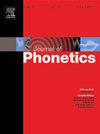Coarticulation and coordination in phonological development: Insights from children’s and adults’ production of complex–simplex stop contrasts in Gã
IF 2.4
1区 文学
0 LANGUAGE & LINGUISTICS
引用次数: 0
Abstract
Achieving adult-like coarticulation, which relies on precise gestural coordination, is known to be a challenging aspect of phonological development. Unique coordination challenges are posed by doubly articulated stops, typologically uncommon complex consonants that show crosslinguistic variation in their acoustic contrast with simplex (singly articulated) consonants. We examined the acoustics and development of complex–simplex stop contrasts between labio-velars (/k͡p/, /ɡ͡b/) and bilabials (/p/, /b/) in Gã (Niger-Congo, Kwa), with special attention to coarticulation with adjacent sonorants. We found that Gã adults mostly produced differences in voice onset time and closure duration to implement these contrasts, and Gã five-year-olds also produced differences in these dimensions. Crucially, however, five-year-olds also produced significant differences in onset formants, which adults did not. These findings provide evidence of age-graded variation in the implementation of complex–simplex stop contrasts in Gã, suggesting that over the course of development there may be a shift away from production of carryover coarticulatory differences toward greater reliance on durational differences. We argue that children’s initial reliance on carryover coarticulation capitalizes on a tendency toward greater consonant–vowel coarticulation as compared to adults, discussing implications for our understanding of how coarticulation develops.
语音发展中的协同发音和协调:来自儿童和成人在Gã中复杂单音停顿对比的见解
实现成人般的协同发音依赖于精确的手势协调,这是语音发展的一个具有挑战性的方面。独特的协调挑战是由双铰接停止,在类型学上不常见的复杂辅音,表现出跨语言的变化,他们的声学对比单一(单铰接)辅音。我们研究了Gã(尼日尔-刚果语,克瓦语)中阴唇-舌尖(/k /p/, / j /b/)和双唇音(/p/, /b/)之间复杂-单音止音对比的声学和发展,特别注意与相邻的辅音的协同发音。我们发现Gã成年人大多在声音开始时间和关闭持续时间上产生差异来实现这些对比,Gã五岁儿童也在这些维度上产生差异。然而,至关重要的是,五岁儿童在发病谱上也有显著差异,而成年人则没有。这些发现为Gã中复杂-单一停止对比的实现提供了年龄分级差异的证据,表明在发育过程中,可能会从产生结转协同发音差异转向更大程度上依赖于持续差异。我们认为,与成人相比,儿童最初对结转协同发音的依赖利用了更大的辅音-元音协同发音的趋势,并讨论了我们对协同发音如何发展的理解的影响。
本文章由计算机程序翻译,如有差异,请以英文原文为准。
求助全文
约1分钟内获得全文
求助全文
来源期刊

Journal of Phonetics
Multiple-
CiteScore
3.50
自引率
26.30%
发文量
49
期刊介绍:
The Journal of Phonetics publishes papers of an experimental or theoretical nature that deal with phonetic aspects of language and linguistic communication processes. Papers dealing with technological and/or pathological topics, or papers of an interdisciplinary nature are also suitable, provided that linguistic-phonetic principles underlie the work reported. Regular articles, review articles, and letters to the editor are published. Themed issues are also published, devoted entirely to a specific subject of interest within the field of phonetics.
 求助内容:
求助内容: 应助结果提醒方式:
应助结果提醒方式:


